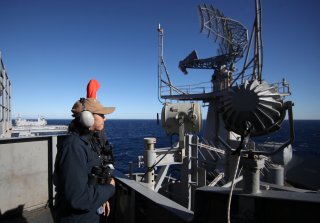The AN/SPY-6 is the Radar System of the Future
An emerging family of highly sensitive Naval radar systems is able to follow multiple incoming threat “tracks” from one integrated system.
The AN/SPY-6 family of radars is a next-generation threat detection system designed to track multiple approaching missile, rocket, drone, or aircraft threats on a single, highly-sensitive threat detection radar system. The longest-range SPY-6 radar, designed to track ballistic missiles, is now being installed on the Navy’s DDG 51 Flight III destroyers. Other variants of the SPY-6 family are being built into amphibious assault ships, carriers, and cruisers in need of effective threat detection systems.
While the SPY-6 radars operate on a common software and hardware technical system, they are scalable and can be adjusted to fit the specific mission requirements of a given platform. A carrier or an amphibious vehicle, for example, may need air and cruise missile defenses but not the ballistic missile defenses that are built into the DDG 51.
Raytheon’s SPY-6 radar transmitter uses a material known as military-grade Gallium Nitride (GaN), a substance that is up to 1,000-times more efficient than the existing Gallium Arsenide used today. A phenomenon known as multi-beam integration is the key to tracking several threats at once. This technology can synthesize horizon scanning and precision tracking with wide-area volume search and ballistic missile defense discrimination.
When it comes to real-world use, SPY-6 radar systems streamline otherwise disparate fire-control and detection technologies. The SPY-6 can cue short-range interceptors as well as longer-range ballistic missile interceptors like SM-3. This shortens sensor-to-shooter time and offers commanders a longer window to make decisions regarding countermeasures. This integration is precisely the kind of defense needed to counter a multi-pronged and coordinated enemy attack.
For example, an approaching ballistic missile might require a longer-range SM-3 interceptor missile, while a sea-skimming cruise missile might require an Evolved Sea Sparrow Block II interceptor. Moreover, an SM-6 or deck-mounted guns may be necessary to target approaching enemy aircraft, while destroying small boats might require the Close-In-Weapons System. All of these systems comprise the different elements of a ship’s layered defenses. Advanced automation and even AI-enabled systems could allow Navy ships to quickly employ many of these weapons to address threats detected by the SPY-6 radar.
Kris Osborn is the Defense Editor for the National Interest. Osborn previously served at the Pentagon as a Highly Qualified Expert with the Office of the Assistant Secretary of the Army—Acquisition, Logistics & Technology. Osborn has also worked as an anchor and on-air military specialist at national TV networks. He has appeared as a guest military expert on Fox News, MSNBC, The Military Channel, and The History Channel. He also has a Master's Degree in Comparative Literature from Columbia University.
Image: Reuters.

